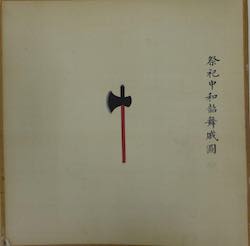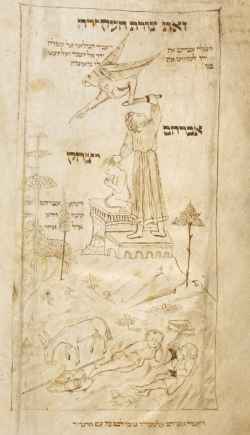Topic: 2. Sacrifice and religion: Comparisons, Antiquarians, Anthropology (16th-18th Century)
Religious sacrifices across various cultures and contexts sparked widespread interest in Early Modern Europe. As Christianity expanded into regions inhabited by "infidels" and "pagans", Europeans encountered a diverse array of sacrificial customs, ranging from the Sati rituals in India to the Aztec sacrifices in the Americas. This cross-cultural exposure captivated a wide audience, including theologians, philosophers, political thinkers, antiquarians, orientalists, missionaries, poets, artists, and even the general public. These encounters broadened the European understanding of sacrifice and led to a critical reassessment of classical and biblical sacrificial rites. This section includes:
- Sources: A selection of early modern printed materials, which include descriptions of the Americas, Asia, and Africa, alongside antiquarian and philological studies on religious sacrifice in classical antiquity and beyond. It also presents early modern works of ethnological observations and the first attempts to compare different sacrificial practices in various traditions and contexts, laying the groundwork for disciplines like the history of religions and anthropology.
- Iconographic Representations: A rich collection of images from the 16th to 18th centuries, illustrating a range of sacrificial rituals and practices as seen in different cultural and geographical contexts.
- Related Bibliography: An extensive bibliography spanning scholarly works from the 19th to 21st centuries, providing contemporary analyses and interpretations of these early studies and observations.
Myth and Cult among Primitive Peoples
Chicago: University of Chicago Press, 1963 [1951].
Le relazioni delle visite apostoliche fra i Pauliciani Bulgari del XVIII secolo
in: Ricerche Slavistiche, v. 50 - 51 (2006 - 2007), issue : pp.85-205 / 45-190.
Agapi cristiane e sacrifici gentileschi sacrifici tra i Bulgari del XVIII secolo
in: Filologia e letteratura nei paesi slavi. Studi in onore di Sante Graciotti, pp. 529-549
Rome: Carocci, 1990.
in: L'accusa del sangue. La macchina mitologica antisemita, pp.
Milano: Bollati Boringhieri, 2007.
The Battle-Axe at Shao Dances at the Offering of Sacrifices Painting (1736-1795)
from: The Illustrated Regulations for Ceremonial Paraphernalia of the Present Dynasty (illustrated manuscript commissioned by the Qianlong Emperor) - Beijing
V&A Museum, London
Sacrifice of Isaac, with captions in Ashkenazi square script. Isaac is kneeling on the altar, Abraham is lifting the knife, but an angel prevents him from hurting his son by grabbing his knife. The same angel points to the ram caught in a bush on the left. Beneath, at the foot of the mountain, the two servants, the donkey and a dog are resting in a field (1460)
from: Add. MS 14759 fol. 1v
British Library, London
Los seis libros de S. Juan Chrysostomo sobre el Sacerdocio. Traducidos en lengua vulgar, ilustrados con notas criticas, y corregidos en esta segunda impresion por [...] Phelipe Scio de San Miguel de las Escuelas Pías
Madrid: Pedro Marín, 1776.
Mimetic Theory, the Wall Paintings, and the Domestication, De-domestication, and Sacrifice of Cattle at Çatalhöyük
in: Violence and the Sacred in the Ancient Near East. Girardian Conversations at Çatalhöyük , pp. 153-164
Cambridge: Cambridge University Press, 2019.
The unbloody sacrifice, and altar, unvail'd and supported. : In which the nature of the eucharist is explain'd according to the Sentiments of the Christian Church in the Four First Centuries. Part the second. Shewing, The Agreement and Disagreement of the Eucharist with the Sacrifices of the Antients, and the Excellency of the former. The great Moment of the Eucharist both as a Feast, and Sacrifice. The Necessity of frequent Communion. The Unity of the Eucharist. The Nature of Excommunication. And the Primitive Method of Preparation. With Devotions for the Altar. I deny not, but that the Fathers do, and that with great reason, very much magnity the wonderful Mystery, and Efficacy of this Sacrament, and frequently speak of a great Supernatural Change made by the Divine Benediction ; which we also readily acknowledge. Archbishop Tillotson, in his Discourse of Transubstantiation, Pag. 291. of his Works in Folio, publish'd in his Life-Time. By John Johnson, A.M.
London: Robert Knaplock, [1718].
Sacrifice in the Greek Magical Papyri
in: Magic and Ritual in the Ancient World, pp. 344–358
Leiden: Brill, 2002.
Animal Sacrifice in Ancient Zoroastrianism: a Ritual and its Interpretations
in: Sacrifice in Religious Experience, pp. 127-148
Leiden: Brill, 2002.
Human Sacrifice at Prambanan
in: Bijdragen Tot de Taal-, Land- En Volkenkunde, v. 152 (1996), issue 1: pp.45-73.
Problems of the Meat Market of Béziers 1240-1247: A Question of Anti-Semitism
in: Revue des Études juives, v. 135 (1976), issue 1-3: pp.31-49.
Histoire critique des dogmes et des cultes
Amsterdam: Honoré, 1704.


